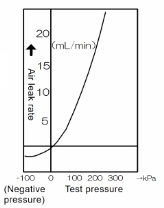Leak rates of gas and liquid
Comparison of Actual Gas and Liquid leak Rates
In general, the leak rates of air and liquid (water, oil) are determined by viscosity and pressure according to Hagen-Poiseuille’s law. However, the leak hole must be a circular tube with a smooth surface. In reality, pinholes caused by leaks or poor welding have complex rough surfaces that are uneven and distorted. In such cases, the correlation between gas and liquid does not necessarily fit the theoretical equation perfectly.
In the case of micro leaks, there is a phenomenon where air leaks but liquid does not leak. In many cases, the ratio of the micro leaks of air and liquid will be greater than the theoretical leak ratio.
This is thought to be due to surface tension between the liquid and the inner surface of the leak hole, which increases flow resistance.
【Note on leak comparisons】
In many cases, due to foreign matter, there is no correlation between the gas and liquid leak rates. In particular, if air is used to measure a leak hole after liquid is used, the air leak may decrease or stop, making it difficult to obtain repeatability. When comparing leak rates, always use air first.
【Note】
Hagen–Poiseuille equation
For gases (compressible)
For liquids (not compressible)
Both are approximate equations.
Symbols

Atmospheric pressure: P0 = 1.013 × 105[Pa abs]
Capillary inlet pressure: P1[Pa abs]
Capillary outlet pressure: P2[Pa abs]
Average pressure: ¯P[Pa abs]
Hole diameter: 2 a[m]
Hole length: L[m]
Fluid viscosity coefficient: η[Pa・s]
1 Pa・s = 1 kg/m・s = 1 N・s/m2 = 1000 cP = 10 Poise or g/cm・s
Theoretical Equation Comparing Leak Rates of Gas and Liquid
Qa: Air leak (atm mL/s)
Ql: Liquid leak (atm mL/s)
ηa: Air viscosity (Pa・s)
ηl: Liquid viscosity (Pa・s)
Pa: Air test pressure (kPa)
Pl: Liquid test pressure (kPa)

【Note】
When the test pressure is changed for the same gas, the leak after the change can be calculated using the following equation.
Leak equation
P1: Test pressure before change (kPa)
P2: Test pressure after change (kPa)
Q1: Leak before change (mL/min)
Q2: Leak after change (mL/min)
In cases where the shape of the leak hole may change when the test pressure is changed, such as a case of gasket leaking, the leak ratio differs from the theoretical equation.